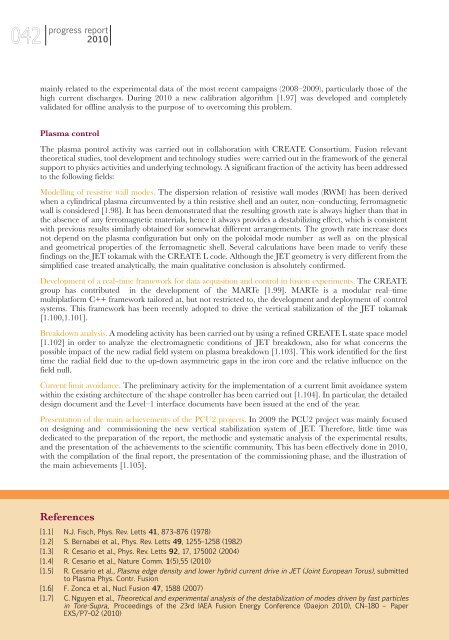Prime pagine RA2010FUS:Copia di Layout 1 - ENEA - Fusione
Prime pagine RA2010FUS:Copia di Layout 1 - ENEA - Fusione
Prime pagine RA2010FUS:Copia di Layout 1 - ENEA - Fusione
You also want an ePaper? Increase the reach of your titles
YUMPU automatically turns print PDFs into web optimized ePapers that Google loves.
042<br />
progress report<br />
2010<br />
mainly related to the experimental data of the most recent campaigns (2008–2009), particularly those of the<br />
high current <strong>di</strong>scharges. During 2010 a new calibration algorithm [1.97] was developed and completely<br />
validated for offline analysis to the purpose of to overcoming this problem.<br />
Plasma control<br />
The plasma pontrol activity was carried out in collaboration with CREATE Consortium. Fusion relevant<br />
theoretical stu<strong>di</strong>es, tool development and technology stu<strong>di</strong>es were carried out in the framework of the general<br />
support to physics activities and underlying technology. A significant fraction of the activity has been addressed<br />
to the following fields:<br />
Modelling of resistive wall modes. The <strong>di</strong>spersion relation of resistive wall modes (RWM) has been derived<br />
when a cylindrical plasma circumvented by a thin resistive shell and an outer, non–conducting, ferromagnetic<br />
wall is considered [1.98]. It has been demonstrated that the resulting growth rate is always higher than that in<br />
the absence of any ferromagnetic materials, hence it always provides a destabilizing effect, which is consistent<br />
with previous results similarly obtained for somewhat <strong>di</strong>fferent arrangements. The growth rate increase does<br />
not depend on the plasma configuration but only on the poloidal mode number as well as on the physical<br />
and geometrical properties of the ferromagnetic shell. Several calculations have been made to verify these<br />
fin<strong>di</strong>ngs on the JET tokamak with the CREATE L code. Although the JET geometry is very <strong>di</strong>fferent from the<br />
simplified case treated analytically, the main qualitative conclusion is absolutely confirmed.<br />
Development of a real–time framework for data acquisition and control in fusion experiments. The CREATE<br />
group has contributed in the development of the MARTe [1.99]. MARTe is a modular real–time<br />
multiplatform C++ framework tailored at, but not restricted to, the development and deployment of control<br />
systems. This framework has been recently adopted to drive the vertical stabilization of the JET tokamak<br />
[1.100,1.101].<br />
Breakdown analysis. A modeling activity has been carried out by using a refined CREATE L state space model<br />
[1.102] in order to analyze the electromagnetic con<strong>di</strong>tions of JET breakdown, also for what concerns the<br />
possible impact of the new ra<strong>di</strong>al field system on plasma breakdown [1.103]. This work identified for the first<br />
time the ra<strong>di</strong>al field due to the up-down asymmetric gaps in the iron core and the relative influence on the<br />
field null.<br />
Current limit avoidance. The preliminary activity for the implementation of a current limit avoidance system<br />
within the existing architecture of the shape controller has been carried out [1.104]. In particular, the detailed<br />
design document and the Level–1 interface documents have been issued at the end of the year.<br />
Presentation of the main achievements of the PCU2 projects. In 2009 the PCU2 project was mainly focused<br />
on designing and commissioning the new vertical stabilization system of JET. Therefore, little time was<br />
de<strong>di</strong>cated to the preparation of the report, the metho<strong>di</strong>c and systematic analysis of the experimental results,<br />
and the presentation of the achievements to the scientific community. This has been effectively done in 2010,<br />
with the compilation of the final report, the presentation of the commissioning phase, and the illustration of<br />
the main achievements [1.105].<br />
References<br />
[1.1] N.J. Fisch, Phys. Rev. Letts 41, 873–876 (1978)<br />
[1.2] S. Bernabei et al., Phys. Rev. Letts 49, 1255–1258 (1982)<br />
[1.3] R. Cesario et al., Phys. Rev. Letts 92, 17, 175002 (2004)<br />
[1.4] R. Cesario et al., Nature Comm. 1(5),55 (2010)<br />
[1.5] R. Cesario et al., Plasma edge density and lower hybrid current drive in JET (Joint European Torus), submitted<br />
to Plasma Phys. Contr. Fusion<br />
[1.6] F. Zonca et al., Nucl Fusion 47, 1588 (2007)<br />
[1.7] C. Nguyen et al., Theoretical and experimental analysis of the destabilization of modes driven by fast particles<br />
in Tore-Supra, Procee<strong>di</strong>ngs of the 23rd IAEA Fusion Energy Conference (Daejon 2010), CN–180 – Paper<br />
EXS/P7–02 (2010)













